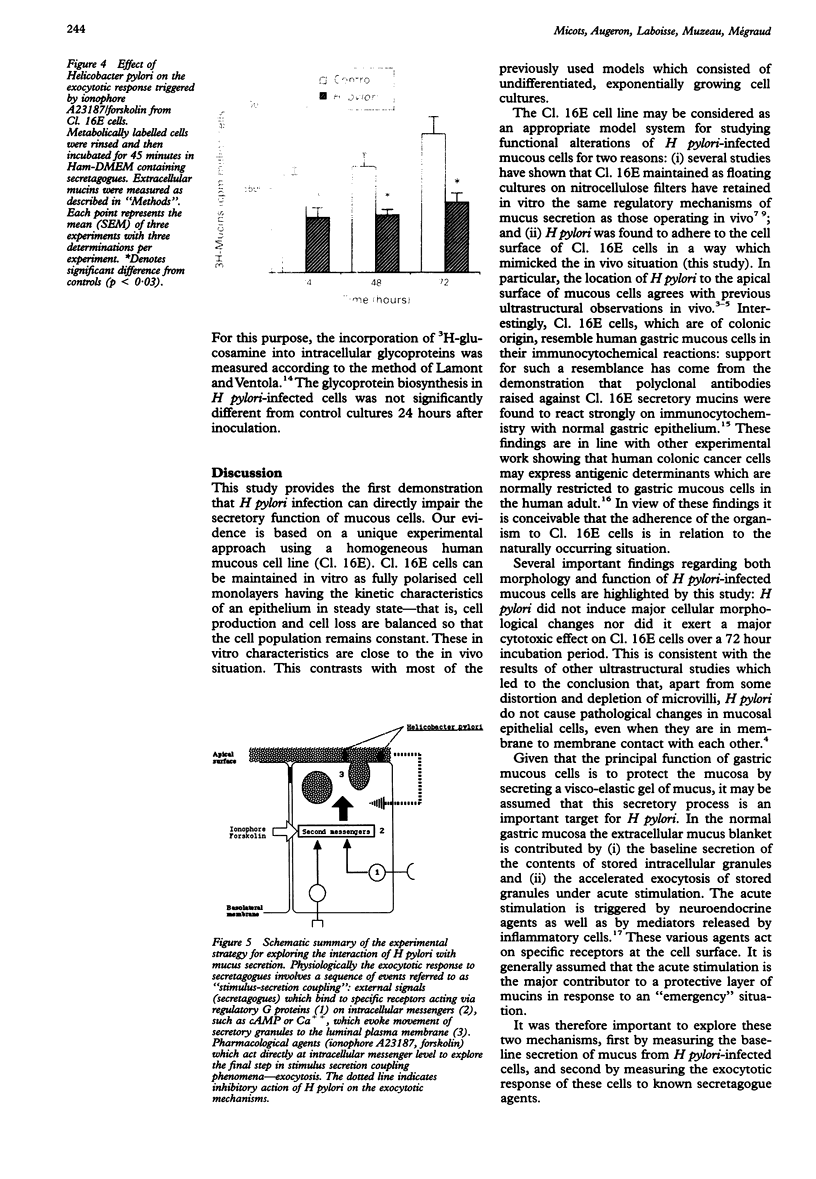Abstract
AIMS: To determine whether Helicobacter pylori impairs the secretory function of mucous cells. METHODS: The mucus secreting human cell line CL. 16E, maintained as confluent monolayers on nitrocellulose filters, was infected with H pylori strain CIP 101260. After three hours of incubation with H pylori the monolayers were washed and reincubated with fresh culture medium for various time periods (24, 48, or 72 hours) before evaluating both the morphology and function of mucous cells. For morphological studies, epithelial monolayers were fixed in situ and processed for both standard histochemistry on paraffin wax sections, and electron microscopy. To measure mucins secreted from cultured cells, the cells were metabolically labelled with 3H-glucosamine. Undegraded mucins were quantitated as the radioactive glycoproteins blocked at the stacker gel interface after sodium dodecyl sulphate-polyacrylamide gel electrophoresis of the secretory glycoproteins. RESULTS: Control cultures of CL. 16E cells grew on filters as homogeneous monolayers of polarised mucous cells secreting a visco-elastic gel of mucins at the apical surface. In infected monolayers H pylori was in close contact with the apical surface of mucous cells. Cell counts and histological evaluation of the monolayers did not reveal any significant deleterious effect of H pylori on the mucous cells. H pylori induced only a modest inhibition of baseline mucus secretion from CL. 16E cells, this inhibition being significant only at 24 hours. In contrast, the mucus secretory response to two agents that raise intracellular cAMP and calcium--forskolin and ionophore A23187--was strongly inhibited. The inhibitory effect of H pylori on the exocytotic response was not paralleled by an inhibition of glycoprotein synthesis. CONCLUSION: Considering the fact that the exocytotic response to a variety of secretagogues constitutes the primary line of defence of the gastric mucosa in an emergency, it is suggested that H pylori exerts its deleterious effects by weakening this important physiological defence.
Full text
PDF




Images in this article
Selected References
These references are in PubMed. This may not be the complete list of references from this article.
- Augeron C., Laboisse C. L. Emergence of permanently differentiated cell clones in a human colonic cancer cell line in culture after treatment with sodium butyrate. Cancer Res. 1984 Sep;44(9):3961–3969. [PubMed] [Google Scholar]
- Bara J., Loisillier F., Burtin P. Antigens of gastric and intestinal mucous cells in human colonic tumours. Br J Cancer. 1980 Feb;41(2):209–221. doi: 10.1038/bjc.1980.32. [DOI] [PMC free article] [PubMed] [Google Scholar]
- Bode G., Malfertheiner P., Ditschuneit H. Pathogenetic implications of ultrastructural findings in Campylobacter pylori related gastroduodenal disease. Scand J Gastroenterol Suppl. 1988;142:25–39. [PubMed] [Google Scholar]
- Chen T. R. In situ detection of mycoplasma contamination in cell cultures by fluorescent Hoechst 33258 stain. Exp Cell Res. 1977 Feb;104(2):255–262. doi: 10.1016/0014-4827(77)90089-1. [DOI] [PubMed] [Google Scholar]
- Chen X. G., Correa P., Offerhaus J., Rodriguez E., Janney F., Hoffmann E., Fox J., Hunter F., Diavolitsis S. Ultrastructure of the gastric mucosa harboring Campylobacter-like organisms. Am J Clin Pathol. 1986 Nov;86(5):575–582. doi: 10.1093/ajcp/86.5.575. [DOI] [PubMed] [Google Scholar]
- Graham D. Y. Campylobacter pylori and peptic ulcer disease. Gastroenterology. 1989 Feb;96(2 Pt 2 Suppl):615–625. doi: 10.1016/s0016-5085(89)80057-5. [DOI] [PubMed] [Google Scholar]
- LaMont J. T., Ventola A. Stimulation of colonic glycoprotein synthesis by dibutyryl cyclic AMP and theophylline. Gastroenterology. 1977 Jan;72(1):82–86. [PubMed] [Google Scholar]
- Laburthe M., Augeron C., Rouyer-Fessard C., Roumagnac I., Maoret J. J., Grasset E., Laboisse C. Functional VIP receptors in the human mucus-secreting colonic epithelial cell line CL.16E. Am J Physiol. 1989 Mar;256(3 Pt 1):G443–G450. doi: 10.1152/ajpgi.1989.256.3.G443. [DOI] [PubMed] [Google Scholar]
- Maoret J. J., Font J., Augeron C., Codogno P., Bauvy C., Aubery M., Laboisse C. L. A mucus-secreting human colonic cancer cell line. Purification and partial characterization of the secreted mucins. Biochem J. 1989 Mar 15;258(3):793–799. doi: 10.1042/bj2580793. [DOI] [PMC free article] [PubMed] [Google Scholar]
- Megraud F., Bonnet F., Garnier M., Lamouliatte H. Characterization of "Campylobacter pyloridis" by culture, enzymatic profile, and protein content. J Clin Microbiol. 1985 Dec;22(6):1007–1010. doi: 10.1128/jcm.22.6.1007-1010.1985. [DOI] [PMC free article] [PubMed] [Google Scholar]
- Neman-Simha V., Mégraud F. In vitro model for Campylobacter pylori adherence properties. Infect Immun. 1988 Dec;56(12):3329–3333. doi: 10.1128/iai.56.12.3329-3333.1988. [DOI] [PMC free article] [PubMed] [Google Scholar]
- Roumagnac I., Laboisse C. L. A simple immunofiltration assay for mucins secreted by a human colonic epithelial cell line. J Immunol Methods. 1989 Sep 1;122(2):265–271. doi: 10.1016/0022-1759(89)90273-1. [DOI] [PubMed] [Google Scholar]
- Roumagnac I., Laboisse C. A mucus-secreting human colonic epithelial cell line responsive to cholinergic stimulation. Biol Cell. 1987;61(1-2):65–68. doi: 10.1111/j.1768-322x.1987.tb00570.x. [DOI] [PubMed] [Google Scholar]
- Seidler U., Sewing K. F. Ca2+-dependent and -independent secretagogue action on gastric mucus secretion in rabbit mucosal explants. Am J Physiol. 1989 Apr;256(4 Pt 1):G739–G746. doi: 10.1152/ajpgi.1989.256.4.G739. [DOI] [PubMed] [Google Scholar]
- Thomsen L. L., Gavin J. B., Tasman-Jones C. Relation of Helicobacter pylori to the human gastric mucosa in chronic gastritis of the antrum. Gut. 1990 Nov;31(11):1230–1236. doi: 10.1136/gut.31.11.1230. [DOI] [PMC free article] [PubMed] [Google Scholar]
- Tricottet V., Bruneval P., Vire O., Camilleri J. P., Bloch F., Bonte N., Roge J. Campylobacter-like organisms and surface epithelium abnormalities in active, chronic gastritis in humans: an ultrastructural study. Ultrastruct Pathol. 1986;10(2):113–122. doi: 10.3109/01913128609014587. [DOI] [PubMed] [Google Scholar]





